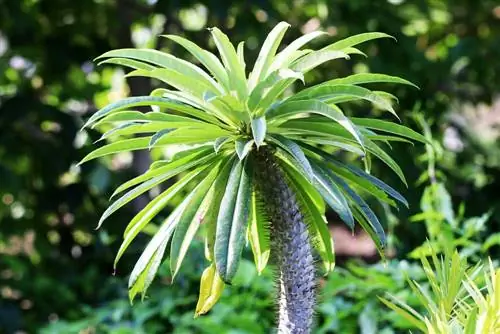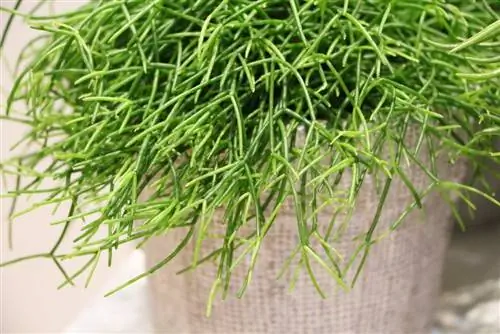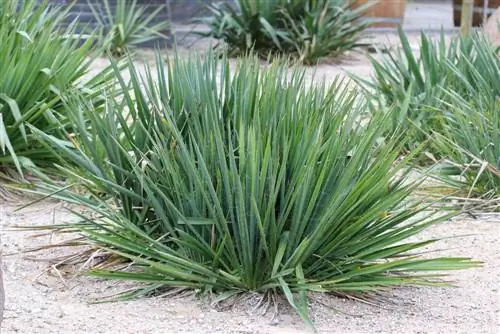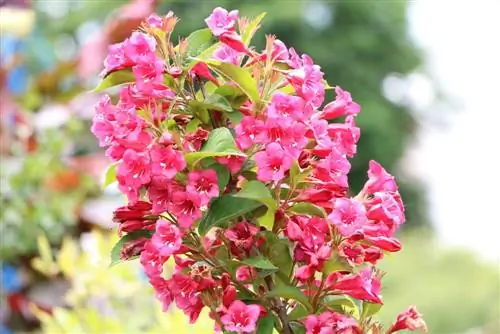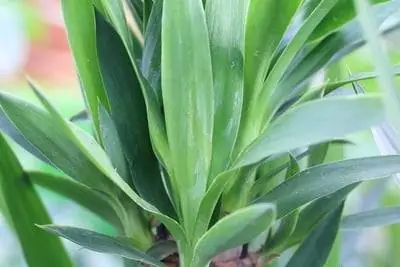- Author admin [email protected].
- Public 2023-12-17 03:39.
- Last modified 2025-01-24 12:45.
The Madagascar palm is visually reminiscent of a palm tree, but is a succulent and is one of the easy-care plants. If her low demands are met, she rewards the effort with an unusual look and even flowers. This makes the houseplant ideal for beginners and anyone without a green thumb. However, the appropriate knowledge of the culture must be present.
Location
The Madagascar palm comes - as the name suggests - from Madagascar and reaches astonishing heights of up to eight meters. In the living room or winter garden it will not reach such dimensions, but it needs the same conditions. This means that it should be as sunny and warm as possible.
Above all, the ratio between light and heat must be right. The brighter the Madagascar palm, also known as thickfoot, is, the higher the temperature must be. However, if it is in light shade, it should be a little cooler. This is crucial, among other things, for preventing diseases and pest infestations. A location on the south side close to the window is therefore ideal. However, a place directly above the heater is unfavorable unless the plant is in the blazing sun or is illuminated with a plant lamp.
Substrate
The initially easiest choice is special substrate for cacti and succulents. However, with the Madagascar palm this requires more frequent watering, fertilizing and repotting - thus continually increasing the care effort. Mixtures that meet the following requirements are more suitable:
- Permeable and loose, not prone to compaction
- Moderately water retaining
- Nutrient Rich
These conditions can be achieved if potting soil or potting soil is mixed with sand, coconut fibers or cactus soil and thus loosened up.
Pouring
As a succulent, the Madagascar palm is undemanding when it comes to watering - but it has a special feature due to its origin. The fatfoot depends on dry seasons and rainy seasons in order to thrive he althily and grow vigorously.
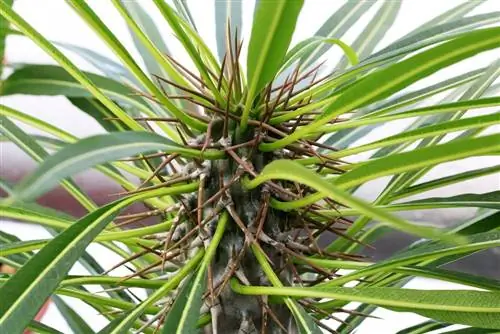
Unfortunately, this cannot be easily determined by the seasons. Instead, the Madagascar palm shows when it is preparing for a dry season and when it needs a rainy season. When it sheds its leaves, the dry phase begins. In this case, watering is carried out very sparingly, i.e. watering just enough so that the substrate does not dry out completely or even become cracked. If the fatfoot forms new leaves, the soil can be kept evenly moist.
In addition, the following points are crucial when watering the Madagascar palm:
- Avoid extremes such as drought and waterlogging
- Use low-lime, soft water
- Do not use cold water for watering
Tip:
If the tap water is very hard, rainwater, untreated pond or aquarium water as well as filtered or stale tap water can be used.
Fertilize
For a succulent, the Madagascar palm has a comparatively high nutrient requirement. However, this also varies depending on the dry seasons and rainy seasons, which can only be recreated in the living room by watering.
During the dry phases, when the fatfoot drops its leaves, it can only absorb a few nutrients. The substrate is then completely sufficient for the supply and no additional fertilization is required. However, if leaves begin to sprout again, fertilizer should be used. Cactus fertilizer or a liquid complete fertilizer in small quantities are suitable. The additional nutrient application can begin four weeks after the first visible growth and continues for four to six months. The Madagascar palm then goes back into the resting phase, in which fertilizing is stopped and watering is reduced.
Freeland
The Madagascar palm can spend the summer outdoors as long as the temperatures are above 15°C at night. For young plants, a consistent minimum temperature of 18°C is safer. Of course, the bigfoot should not be planted outdoors, but should continue to be cultivated in a pot. In addition, the following factors should be taken into account when choosing the location:
- As sunny as possible, direct sunlight is ideal
- Protected from cold wind and heavy rain
- Warm, for example in a corner or near a wall
If drops in temperature are to be expected, the Madagascar palm should be brought indoors.
Tip:
If you don't want to constantly move the succulent, you can also give it a place by the open window in summer.
Repotting
How often repotting is necessary depends on the substrate chosen. Cactus soil needs to be changed at least every two years. With potting soil or potting soil, it can be three or four years between repotting.
On the other hand, the size of the Madagascar palm is of course also a crucial factor. If the planter has roots, a larger pot should be chosen. It is sufficient to choose the container one size larger. In this way, watering can be more economical as less substrate needs to be completely moistened.
Changing the soil or repotting should take place at the start of the rainy season, i.e. when the leaves sprout again. Gloves must be worn during the measure in order to avoid skin contact in the event of possible damage to the plant and escaping plant sap.
Tip:
The thorn-proven trunk of the Madagascar palm can become a problem when repotting. To avoid injuries, it can be wrapped with paper or provided with Styrofoam plates.
Wintering

The Madagascar palm does not require any special wintering, but does require the dry season mentioned above. This usually occurs in the cold months, but can also occur in summer. This depends on the plant and can only be influenced to a limited extent from the outside. So a close look is required here. However, a change of location is not necessary. Only watering needs to be reduced and fertilization stopped. The Madagascar palm indicates the end of the dormant phase by sprouting new leaves. It can also be repotted at this time.
Cutting
The Madagascar palm does not need any waste and generally does not tolerate it well. Only damaged or diseased leaves should be shortened or removed.
A clean and sharp cutting tool, i.e. scissors or a knife, is used for this. To protect the skin from direct contact with escaping plant sap, gloves should be worn and the cutting tool should be cleaned thoroughly afterwards.
Propagate
The Madagascar palm can be propagated by seeds or side shoots. However, patience is necessary for both variants, as the thick-footed tree only develops flowers and side shoots after several years.
Side shoots
If you want to try it, you should prefer to propagate the Madagascar palm via side shoots. This way is faster and requires less effort. The procedure is as follows:
- The side shoot is cut off close to the mother plant with a sharp and clean knife when it is strong and at least five, preferably ten, centimeters long.
- The interface is treated with rooting powder and then left to dry for a day. Drying reduces the risk of rot.
- The shoot is then inserted two to three centimeters deep into potting soil or the substrate mixture of the mother plant. The soil should be kept moist but not wet.
- The planter must be warm and bright. In order to keep the effort required for watering low and to promote rooting of the shoot, the pot can be covered with foil or a hood or placed in a greenhouse.
The propagation is visibly successful when the shoot grows and develops new leaves.
Seeds
If you decide to propagate using seeds, you have to put in a little more effort and proceed as described below:
- If flowers form, they are pollinated with a brush. Even if the Madagascar palm is outdoors, pollination by insects is not guaranteed.
- After successful pollination, seeds form that can be collected by the fatfoot. If they are not to be sown immediately, they can be stored in a dark and dry place.
- For germination, they are placed on potting soil or the substrate mixture described and only lightly covered with it.
- The substrate is well moistened and is best sprayed for this purpose.
- Bright and placed at 24 to 30°C, germination takes several weeks. A heated indoor greenhouse is ideal as a location for this time. If this is not available, the planter should be covered again to maintain warmth and moisture.
- When the height of around ten centimeters has been reached, the young plants are separated and repotted and no longer need to be covered. Keeping the substrate moist is still important, especially at the beginning.
Typical care errors, diseases and pests
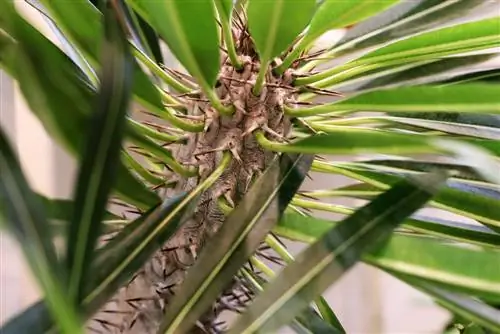
Due to its origins in this area, the Madagascar palm is rarely affected by diseases and pests. However, scale insects and fungal infections can occur.
Scale insects
Scale insects suck the plant sap and can thereby cause malformed growth and discoloration. The pests, as well as their sticky secretions, can be clearly seen on the Madagascar palm. However, combating them is comparatively easy:
- Thorough rinsing and gentle brushing of the growth
- Use of natural oil-based pesticides
- Removal of predators, such as ladybirds, lacewings, hoverflies or floral wasps
Fungal Infection
If a fungal infection or rot spreads, the leaves not only change color, they also wither and fall off prematurely. The substrate also emits a musty, moldy smell and a whitish or gray coating can form on it. The fungal spores can also spread through cracks or injuries in the leaves and bark - i.e. not initially found in the substrate. To save the Madagascar palm, the following measures are important:
- Remove affected plant parts with a sharp knife or scissors and allow the cut areas to dry
- Immediate and thorough change of the entire substrate
- Regulation of the watering quantity
Rot
The rot in particular can be traced back to two typical care errors. This can be either a lack of watering or excessive watering. If the Madagascar palm lacks water, the leaves, trunk and bark become wilted, limp and cracked. This means germs can spread more easily. Waterlogging promotes rot very directly and especially in the substrate. Other typical mistakes in the cultivation of the Madagascar palm include:
- Too dark location
- Inappropriate ratio between heat and light - for example rather dark but very high temperatures
- Soil cold
- Substrate that tends to compact or has a low nutrient content
- Rare watering
- Using hard water
- Lack of compliance with dry phases and rainy seasons
Caution: Toxic
All parts of the Madagascar palm are poisonous, so care should be taken when cutting and the skin should be protected from direct contact with the plant sap. In addition, in households with small children and animals who might come into contact with it while playing or ingest plant parts, it should be kept out of reach or the thick foot should be avoided.

